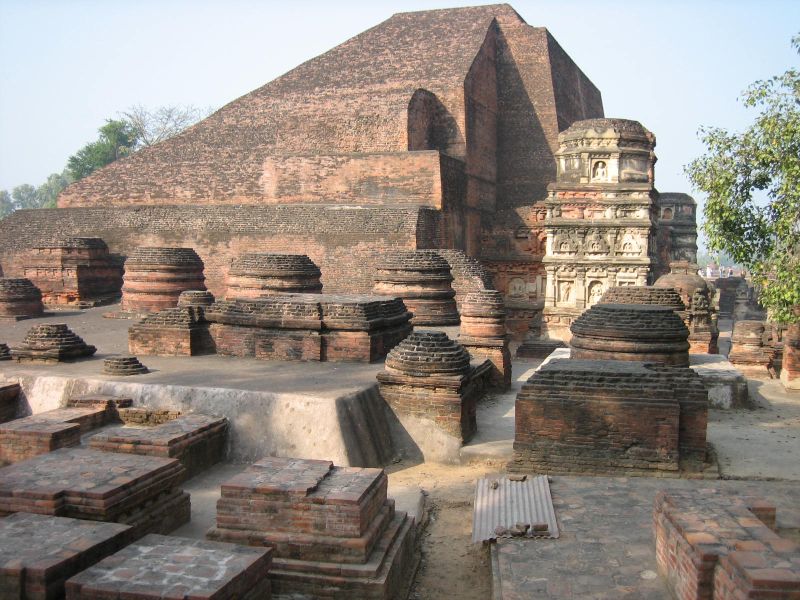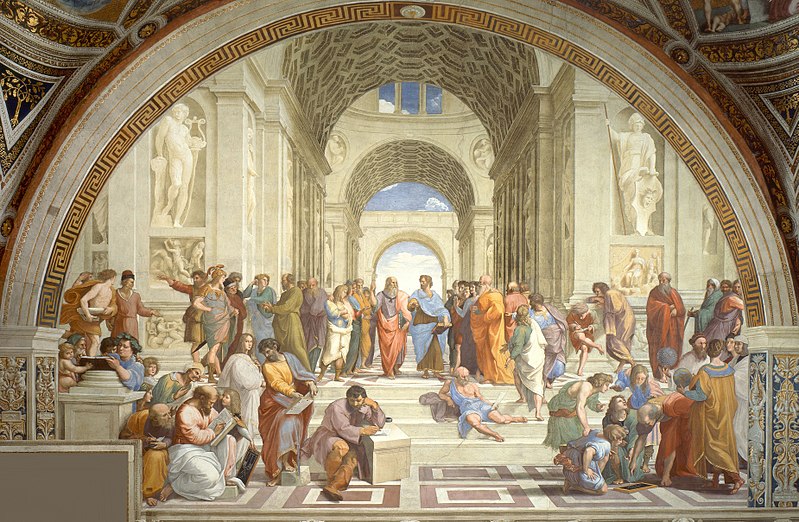A variety of ancient higher-learning institutions were developed in many cultures to provide institutional frameworks for scholarly activities. These ancient centres were sponsored and overseen by courts; by religious institutions, which sponsored cathedral schools, monastic schools, and madrasas; by scientific institutions, such as museums, hospitals, and observatories; and by individual scholars. They are to be distinguished from the Western-style university which is an autonomous organization of scholars that originated in medieval Europe and was adopted in other world regions since the onset of modern times (see list of oldest universities in continuous operation).
Europe and Near East
Hellenism
The Platonic Academy (sometimes referred to as the University of Athens), founded ca. 387 BC in Athens, Greece, by the philosopher Plato, lasted 916 years (until AD 529) with interruptions. It was emulated during the Renaissance by the Florentine Platonic Academy, whose members saw themselves as following Plato's tradition.
Around 335 BC, Plato's successor Aristotle founded the Peripatetic school, the students of which met at the Lyceum gymnasium in Athens. The school ceased in 86 BC during the famine, siege and sacking of Athens by Sulla.
During the Hellenistic period, the Museion in Alexandria (which included the Library of Alexandria) became the leading research institute for science and technology from which many Greek innovations sprang. The engineer Ctesibius (fl. 285â€"222 BC) may have been its first head. It was suppressed and burned between AD 216 and 272, and the library was destroyed between 272 and 391.
The reputation of these Greek institutions was such that three modern words derive from them: the academy, the lyceum and the museum.
Christian Europe
The Pandidakterion of Constantinople, founded as an institution of higher learning in 425, educated graduates to take on posts of authority in the imperial service or within the Church. It was reorganized as a corporation of students in 849 by the regent Bardas of emperor Michael III, is considered by some to be the earliest institution of higher learning with some of the characteristics we associate today with a university (research and teaching, auto-administration, academic independence, et cetera). If a university is defined as "an institution of higher learning" then it is preceded by several others, including the Academy that it was founded to compete with and eventually replaced. If the original meaning of the word is considered "a corporation of students" then this could be the first example of such an institution. The Preslav Literary School and Ohrid Literary School were the two major literary schools of the First Bulgarian Empire.
In Western Europe during the Early Middle Ages, bishops sponsored cathedral schools and monasteries sponsored monastic schools, chiefly dedicated to the education of clergy. The earliest evidence of a European episcopal school is that established in Visigothic Spain at the Second Council of Toledo in 527. These early episcopal schools, with a focus on an apprenticeship in religious learning under a scholarly bishop, have been identified in Spain and in about twenty towns in Gaul during the 6th and 7th centuries.
In addition to these episcopal schools, there were monastic schools which educated monks and nuns, as well as future bishops, at a more advanced level. Around the turn of the 12th and 13th centuries, some of them developed into autonomous universities. A notable example is when the University of Paris grew out of the schools associated with the Cathedral of Notre Dame, the Monastery of Ste. Geneviève, and the Abbey of St. Victor.
India and the Subcontinent

The schools at Nalanda, Pusphagiri, Takshila and Vikramshila were some of the primary institutions of higher learning in ancient India.
Puspagiri
The school in Puspagiri was established in the 3rd century AD as present Odisha, India. As of 2007, the ruins of this Mahavihara had not yet been fully excavated. Consequently, much of the Mahavihara's history remains unknown. Of the three Mahavihara campuses, Lalitgiri in the district of Cuttack is the oldest. Iconographic analysis indicates that Lalitgiri had already been established during the Sunga period of the 2nd century BC, making it one of the oldest Buddhist establishments in the world. The Chinese traveller Xuanzang (Huien Tsang), who visited it in AD 639, as Puphagiri Mahavihara, as well as in medieval Tibetan texts. However, unlike Takshila and Nalanda, the ruins of Puspagiri were not discovered until 1995, when a lecturer from a local college first stumbled upon the site. The task of excavating Puspagiri's ruins, stretching over 143 acres (0.58Â km2) of land, was undertaken by the Odisha Institute of Maritime and South East Asian Studies between 1996 and 2006. It is now being carried out by the Archaeological Survey of India (ASI). The Nagarjunakonda inscriptions also mention about this learning center.
Nalanda
Nalanda was established in the fifth century AD in Bihar, India. Founded in 427 in northeastern India, not far from what is today the southern border of Nepal, it survived until 1197. It was devoted to Buddhist studies, but it also trained students in fine arts, medicine, mathematics, astronomy, politics and the art of war.
The center had eight separate compounds, ten temples, meditation halls, classrooms, lakes and parks. It had a nine-story library where monks meticulously copied books and documents so that individual scholars could have their own collections. It had dormitories for students, perhaps a first for an educational institution, housing 10,000 students in the school’s heyday and providing accommodation for 2,000 professors. Nalanda attracted pupils and scholars from Sri Lanka, Korea, Japan, China, Tibet, Indonesia, Persia and Turkey.
Taxila
Taxila or Takshashila, in ancient India (modern-day Pakistan), was an early Hindu and Buddhist centre of learning. According to scattered references that were only fixed a millennium later, it may have dated back to at least the fifth century BC. Some scholars date Takshashila's existence back to the sixth century BC. The school consisted of several monasteries without large dormitories or lecture halls where the religious instruction was most likely still provided on an individualistic basis.
Takshashila is described in some detail in later JÄtaka tales, written in Sri Lanka around the fifth century AD.
It became a noted centre of learning at least several centuries BC, and continued to attract students until the destruction of the city in the fifth century AD. Takshashila is perhaps best known because of its association with Chanakya. The famous treatise Arthashastra (Sanskrit for The knowledge of Economics) by Chanakya, is said to have been composed in Takshashila itself. Chanakya (or Kautilya), the Maurya Emperor Chandragupta and the Ayurvedic healer Charaka studied at Taxila.
Generally, a student entered Takshashila at the age of sixteen. The Vedas and the Eighteen Arts, which included skills such as archery, hunting, and elephant lore, were taught, in addition to its law school, medical school, and school of military science.
Other
Further centers include Telhara in Bihar (probably older than Nalanda), Odantapuri, in Bihar (circa 550 - 1040), Somapura, in Bangladesh (from the Gupta period to the Turkic Muslim conquest), Sharada Peeth, Pakistan, Jagaddala, in Bengal (from the Pala period to the Turkic Muslim conquest), Nagarjunakonda, in Andhra Pradesh, Vikramaśīla, in Bihar (circa 800-1040), Valabhi, in Gujarat (from the Maitrak period to the Arab raids), Varanasi in Uttar Pradesh (eighth century to modern times), Kanchipuram, in Tamil Nadu, Manyakheta, in Karnataka, Mahavihara, Abhayagiri VihÄra, and Jetavanaramaya, in Sri Lanka.
East Asia

In China, the ancient imperial academy known as Taixue was established by the Han Dynasty in AD 3. It was intermittently inherited by later dynasties until Qing, in some of which the name was changed to Guozixue or Guozijian. Peking University (Imperial University of Peking) established in 1898 is regarded as the replacement of Taixue (or Guozijian). In Korea, Taehak was founded in 372 and Gukhak was established in 682. The Seonggyungwan was founded by the Joseon Dynasty in 1398 to offer prayers and memorials to Confucius and his disciples, and to promote the study of the Confucian canon. It was the successor to Gukjagam from the Goryeo Dynasty (992). It was reopened as a private Western-style university in 1946. In Japan, Daigakuryo was founded in 671 and Ashikaga Gakko was founded in the 9th century and restored in 1432. In Vietnam, the Quoc Tu Giam (國å監, literally "National University") functioned for more than 700 years, from 1076 to 1779.
Ancient Persia
The Academy of Gundishapur was established in the 3rd century AD under the rule of Sassanid kings and continued its scholarly activities up to four centuries after Islam came to Iran. It was an important medical centre of the 6th and 7th centuries and a prominent example of higher education model in pre-Islam Iran. When the Platonic Academy in Athens was closed in529, some of its pagan scholars went to Gundishahpur, although they returned within a year to Byzantium.
See also
- Madrasah
- Medieval university
References
- Furley, David (2003a), "Peripatetic School", in Hornblower, Simon; Spawforth, Antony, The Oxford Classical Dictionary (3rd ed.), Oxford University Press, ISBNÂ 0-19-860641-9Â
- Irwin, T. (2003), "Aristotle", in Craig, Edward, Routledge Encyclopedia of Philosophy, RoutledgeÂ
- Lynch, J. (1997), "Lyceum", in Zeyl, Donald J.; Devereux, Daniel; Mitsis, Phillip, Encyclopedia of Classical Philosophy, Greenwood Press, ISBNÂ 0-313-28775-9Â
- Riché, Pierre. Education and Culture in the Barbarian West: From the Sixth through the Eighth Century. Columbia: University of South Carolina Press, 1978. ISBN 0-87249-376-8.
Notes
External links
- Ancient Buddhist Monastic Establishments in Bangladesh







0 komentar :
Posting Komentar